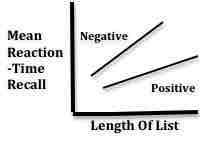Serial memory processing is the act of attending to and processing one item at a time, while parallel memory processing is the act of attending to and processing all items simultaneously. In short-term memory tasks, participants are given a set of items (e.g. letters, digits) one at a time and then, after varying periods of delay, are asked for recall of the items. Participants could also be asked whether a specific target item was present in their original set. The serial order of items and the relationships between them can have varying effects on speed and accuracy of recall.
Serial Memory Processing
Serial memory processing compares internal representations of the memory set to a target stimulus or item is being presented, one at a time. Reaction time increases linearly with the set size, which means the more items in the memory set, the longer it will take to compare.
Serial memory processing can be either self-terminating or exhaustive.
Self-Terminating Processing
Self-terminating implies that comparisons stop abruptly as soon as the target is found, and then the response is generated. Evidence for this method is found in reaction time studies. If the reaction time slope for a positive trial (where the target was present in the memory set) is about half of the slope for a negative trial (where the target was not present in the memory set), this demonstrates self-terminating processing . This is because on average, participants (on positive trials) will stop comparisons about halfway through when they find the target match, but participants (on negative trials) must compare until the end when no target match is found.

Self-Terminating Search
This line graph depicts both positive and negative self-terminating search, comparing length of list to mean reaction time recall.
Exhaustive Processing
On the other hand, exhaustive implies that comparisons continue until the entire set is compared and then a response is generated . Evidence for this method is also found in reaction time studies. In this case, the reaction time slope is equal for both positive and negative trials, as comparisons are made to the end in both cases. Participants may process some serial memory sets using the self-terminating method and others with the exhaustive method. There is no clear distinction about which method is better to use.
Parallel Processing
Parallel processing is the ability to carry out multiple operations or tasks simultaneously. The term is used in the contexts of human cognition, particularly in the ability of the brain to simultaneously process incoming stimuli, and in parallel computing by machines.
In parallel processing, the brain simultaneously processes incoming stimuli of differing quality. This is most important in vision, as the brain divides what it sees into four components: color, motion, shape, and depth. These are individually analyzed and then compared to stored memories, which helps the brain identify what you are viewing. The brain then combines all four components into the field of view that you see and comprehend. This is a continual and seamless operation.